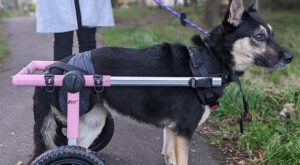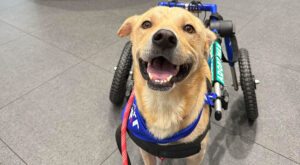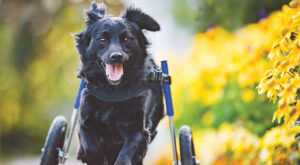Emotional support animals are one of the greatest ways to relieve the symptoms of disabilities, whether they be physical or mental health. If you’re thinking of getting one to assist you, there are some things you should know first, like what emotional support animals are and how they differ from pets and service animals.
What are Emotional Support Animals?
An emotional support animal (ESA) is an animal that provides support and comfort to disabled and neurodiverse individuals. The most common ESAs are dogs, but there is no single type of ESA—they vary from cats, horses, monkeys, pigs, etc., as long as they provide emotional help to people who need them. They can come with you to many locations as long as you follow proper pet policies and the pet is friendly.
Before an animal becomes an ESA, they need to be evaluated by a therapist first. Once certified, they will have rights that regular house pets don’t, such as protection under the Fair Housing Act. Recent changes in Emotional Support Animal regulations may restrict air travel for ESAs. Before flying, check with your airline for their most updated rules and regulations.
Teaching and Introducing Basic Commands
Before your dog can begin training as an ESA, there are a few basic commands that all emotional support animals must master first:
1. House Training
If you’re already dead set on having your pet become an emotional support animal, you have to have them house trained. Doing this requires a whole bunch of different tasks that you need to follow religiously.
Feed them on schedule.
When you feed a puppy or other young animal, ensure they are fed only at a particular time. This way, you can easily monitor when they will have to go outside to potty or when they need to use their litterbox. A dog’s digestive system usually does the job quickly, so you can take them out within a half hour after eating. Once your dog is used to the schedule, they will immediately know what to do after they eat. Much of this will be the same for pets who use a litterbox indoors, and you will have to move your pet to their box after eating.
Take them to the same place.
You have to be consistent in your house training. Likewise, when taking them out or to their box, you need to go to the same place and spot every single time so that they can fix this image in their mind. Once they see that place, they will know where they need to go for potty.
Make home restrictions.
Your pet is usually hard to train when they’re still young, but this is the perfect time to do it because they will be able to retain the training when they grow up. While you’re still easing into the process, restrict parts of your house so you can avoid accidents in the future—nobody likes to have their couches ruined with pee or their favorite carpet stained with poop.
Have treats ready.
Treats are a good way to train your pet. When they go potty where they should, give them a treat as a reward to enforce positive conditioning.
Remove their water a few hours before they sleep.
Removing their water bowl will help them avoid peeing late at night while you’re asleep.
2. Teach Them How to Sit
This is one of the easiest commands you can teach your pet. To teach an aspiring ESA to sit, first hold a treat in front of them. Make sure you hold it at the level of their nose. After they are fixated on the treat, move it upward and towards their back so they can look up and proceed to a sitting position. Always use the word ‘sit’ when doing this. Once they sit, give them words of encouragement, praise them for what they did, and give them the treat. After a few rounds, they will be able to master this command.
3. Teach Them to Stay
After they learn to sit, practice this a couple more times so they are familiar with it. Once they know the command, ask them to sit again and start moving away slowly. If they follow you, ask them to stay. Once they successfully do the command or action needed, give them a treat and let them know that they did a good job.
4. Ask Them to Come
In teaching them to come near you, you should first introduce them to the word. After that, put them in their leash and ask them to stay while holding the end of the leash at your hand. Once they are seated, start pulling the leash in an encouraging motion while saying the word come. Just like any other command training, once they do it right, give them a treat as well as words of praise.
5. Teach Team to Lie Down
Your dog, or any aspiring ESA for that matter, should learn how to lie down. To train your animal how to do this, hold a treat in front of their nose and lower it slowly to the ground until they assume a lying position, all while saying the word down. Again, give them treats and praises when they achieve the command. Once they perfect it, you can change the hand signal by placing your palm to the ground.
6. Teach Them to Leave Things Alone
Sometimes, your pets are easily distracted by small noises or things that may catch their attention. This will cause them to shift their concentration and instead focus on the distraction ahead. One of the things you could do is to put a treat in your hand, and when they try to steal the treat, you can then close your hand until they back off. Do this again and again until they understand that there is a right time to do things. You can also offer their favorite toys or use a leash if necessary.
Walking on a Leash with Emotional Support Animals
Before doing anything, invest in a good leash or a recommended harness. To teach your Emotional Support Animal to walk on a leash, introduce them first to the outdoors. This may sound scary, but it’s actually easy if you use an effective outdoor training technique. The key is to use treats, praise, and negative reinforcement in order to motivate them to do what you want. Begin by teaching them to sit at your feet while you give them the command to sit. Once they comply, then you can begin to increase the distance between you while asking them to stay within your reach.
Following Commands While Leash Walking
The next step on how to train your Emotional Support Animal to walk on a leash correctly involves patience. There’s no point in asking them to sit and then having to guide them into a ‘sit’ position themselves. The key here is to have them sit first, then guide them into a sitting position by saying ‘stay’ while holding your hand in front of their nose. You can do this until they’ve sat down, then praise them and give them a treat so that they learn to associate good behavior with something positive. Basically, you will have to reintroduce the basic commands you taught your ESA, but this time in the context of being on the leash.
Staying Nearby While on a Leash
After making sure that they stay within your reach at all times, you can start to increase the distance between you. Start to walk alongside of the street or in front of a store. If they get too close to the road, change directions and walk in the opposite direction. This way, they get used to walking along the leash on which they are traveling. Soon, when they are comfortable with both walking along the street as well as just walking on the leash, you can begin to ask them to follow you without taking the lead.
It is also important to keep in mind that you will need to walk in the same direction, and at the same speed, every time you train your ESA to walk on a leash. That said, it is perfectly acceptable to vary your walks to allow them to see new sights and to learn new behavior patterns. As long as you keep your walk relatively similar, and always reward good behavior with treats, your aspiring ESA will soon learn that it best to stay by your side rather than try to run off.
Emotional Training
The commands introduced earlier were all basic commands you can teach any animal as long as you have the patience to do so. However, Emotional Support Animals can do more than just follow basic commands, provided you give them the training for it.
ESAs do not need to undergo the same kind of training as service animals as ESA certification is not dependent on the animal’s abilities but rather their owner’s emotional needs. However, if you choose to do so, you could train your ESA to have some of the same skills that some kinds of service animals are taught. This kind of training will be more difficult than basic behavioral training, and a lot of concentration will be required from the animal undergoing this developmental activity. You may require the assistance of a professional trainer to fully train your ESA.
Deep Pressure Therapy
One of the most common trainings is applying deep pressure therapy. Most commonly required of service animals, deep pressure therapy can be used to train an ESA as well. Deep pressure therapy is applying small amounts of pressure to parts of your body to reduce or take away one’s anxiety. Smaller animals can achieve this by sitting on you, while bigger animals can do this by putting their head on a part of your body or by simply using their paws to apply the needed pressure.
Follow these simples steps to teach your pet deep pressure therapy:
- Teach them to go up and down a sofa at command.
- Move them to the right position in a calm manner so that they will trust you.
- Teach them to take their paws off when needed. You can also ask them to stay down as the need arises.
- Make sure they are taught to calm down. The calmer they are, the more they will be able to help the person who needs them. When they jump around, lick, or bark, reprimand them immediately. In teaching, you need to exert a lot of effort and extend your patience as much as you can.
- Give them treats the moment they do it right and always tell them that they are doing well to encourage their behavior.
- Once they are more familiar with the commands, slowly decrease the amount of treats you are giving them so that they can adopt the command like it is second nature to them.
Comfort and Socialization
Emotional support animals can be brought to many different locations, so it’s important to train the animal to be sociable. This way, when other people are present or when there are other animals roaming around the vicinity, they don’t make too much of a fuss about it or overreact. This will also help their owner to be calm in certain situations.
Animals can be easily taught to be sociable as young as three weeks old. You can arrange play dates with other animals—ideally a variety of different animals so your ESA will be used to all kinds of creatures—and teach them to stay calm in certain situations.
Likewise, you can introduce different toys to ensure positive stimulations. This will allow them to exercise their minds and be smart with their actions. Aside from this, introducing them to grooming at a young age will allow them to easily adjust to other people handling them. Usually going to the groomers is scary for animals, but once they get used to it, they become calmer and more collected, and they will learn to trust people not to hurt them. It is also important to introduce them to different sounds from time to time. Some sounds might feel too loud for them like fireworks and storm rumbles. Thus, it is important that during these situations, they can feel that they are safe.
Importance of ESAs
Emotional service animals are very important as they can help lighten your anxiety or reduce your stress. However, make sure you really need an ESA before you get one because if you’re only getting an ESA for companionship, you will not be able to maximize their abilities. Likewise, if you want to have an ESA, it’s important to train them while they are still young.
If you don’t want to use ESAs, you may want to consider having a pet to cuddle with and affectionate toward. Having a pet to take in your home with other pets to play with can make all the difference between making a good companion or being on the streets by yourself. Even if you have a small yard, it’s better to have a pet than not. Life is too short for us to live alone!


Related Articles:
Did we answer all your questions on "ESA Pets"?










I would like to start out by saying that I love that your wheelchair helped my retired service dog to walk again. It was well worth the money I spent just to see her walk again. Sadly, I had to lay her to rest and am currently training my next service dog. With that said I would be more than happy to give a presentation on service dogs and emotional support animals to you all as there seems to be some misinformation here about ESA’s.
“ESAs do not need to undergo the same kind of training as service animals as ESA certification is not dependent on the animal’s abilities but rather their owner’s emotional needs.” Don’t let organizations fool you about this. There is no certification for ESA’s, just like with service dogs and service miniature horses. In fact, there is no specialty training of any kind for ESA’s to undergo. Deep pressure therapy and grounding are service animal tasks. Unless the animals are some other domestic animals, dogs or miniature horses with this training (as well as other training) would fall under service animal status.
“Emotional support animals can be brought to many different locations…” As long as the locations are pet friendly than this is the case. However, ESA’s are not required to have specialty training and so are not allowed in no-pet places. Only service animals may go anywhere their handlers goes. You are correct that they are protected by the Fair Housing Act and used to be protected by the Air Carrier Access Act but are no longer protected by this act as it has recently been changed.
There’s a lot of information that gets mixed up between service animals and emotional support animals that it’s sometimes hard to understand it correctly. Please feel free to reach out with either any questions or if you’re interested in my presentation.
Thank you so much for the products that you put out, they make a profoundly positive impact on the animal community.
With warm regards,
Helena Lewis